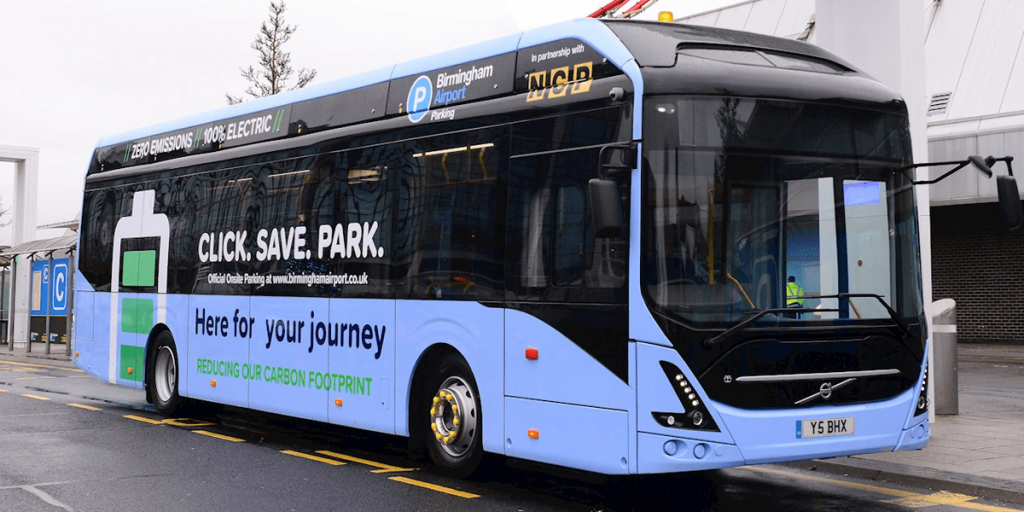
Large international airports are the source of a substantial amount of traffic in surrounding areas and also a large amount of revenue for taxi and shuttle services. Just arriving at the airport you will usually see long lines of taxis, vehicles picking up and dropping off loved ones and shuttle services all waiting for the passenger to load or unload the vehicles. It is no doubt that these services are needed, but how do we make them less damaging to the environment?
There are significant downsides of the conventional taxi services at airports. One of the downsides is that a taxi or ridesharing company dropping off a passenger may only stay there until the passenger has left, and cannot wait there for a longer period to pick up another customer. This means that taxis are forced to leave and rack up miles with no customer in the car, which is bad for the taxi company and the environment. Fuel efficiency can also be a problem, with ridesharing vehicles and taxis not meeting fuel efficient standards. Taxi services and ridesharing companies usually only pick up one passenger, therefore creating more traffic and more pollution than carpooling. There are ways for airports to control these negative environmental effects and take action for sustainable airport operations, just like some of the leading airports in their taxi, ridesharing and shuttlebus sustainability.
In 2003, Seattle-Tacoma International Airport (SEA) set environmental standards for their taxi services, and ride-sharing companies such as Uber, Lyft and Wingz have been subject to this standard as of 2016. Each vehicle that provides service at the airport must meet fuel efficiency and emissions standards of 45 MPG or use alternative fuels, promotes carpooling among customers, and are taking measures to decrease the miles driven without a passenger. Taxis and ridesharing companies must create monthly reports (which are done by transportation network companies) of data for the SEA on pick-ups, drop-offs, and other driving activities when servicing passengers of the airport in order to ensure that these companies are participating in the airport standards of service. Each vehicle is subject to a $5 per pickup fee at the airport, and if companies do not meet the environmental performance standards after six-month and nine-month periods, they incur additional $5 per trip fees until they have reached the Port’s standards. Stephanie Meyn, manager of the Climate Protection Program at the airport says, “for one thing, drivers operating under the Uber app know they need to get at least 45 mpg on their vehicles in order to pick up passengers, so they buy various hybrid or electric models. Ultimately, this saves them money on gas”. To manage the amount of miles driven without a customer and airport traffic, SEA has established a holding lot specifically for ridesharing drivers. This means that once drivers drop off their customer, they can turn off their car and wait for another passenger to need a ride home.
Since implementing these standards at the airport, SEA has seen a surge in the number of hybrid vehicles picking up and dropping off passengers at the airport. According to Nielson Scarborough market research, approximately 5% of all vehicles in the area are hybrids – nearly double the national average. For the traffic at SEA, the Toyota Prius is by far the leading hybrid model for transporting passengers to and from the airport, as well as the Nissan leaf electric vehicle.
Zürich Airport released their new Airport Taxi Zürich hybrid cars and ten hydrogen-powered vehicles this year dedicated for picking up and dropping off passengers. The company also boasts that the hydrogen-powered cars also filter particulate matter out of the air while driving. The airport is offering passengers half-price, flat rate deals for pre-ordering the more sustainable taxis, giving people incentive to choose the greener option. Zürich airport has a goal of offsetting all of its CO2 emissions from its taxis by financing climate protection projects, therefore making the taxiing services carbon neutral.

For sustainable shuttle services, the Indianapolis International Airport is doing their best to reduce their emissions one shuttle at a time. In 2017, the airport launched the nation’s largest electric airport shuttlebus fleet to transport passengers to and from the airport. This move is estimated to reduce the airport’s carbon footprint by 15 million pounds, replacing 66,000 gallons of diesel fuel annually. In the ten-year life of these buses, they are expected to save $2 million in operating and maintenance costs, making the implementation of these buses economical as well as sustainable.
These incredible examples of environmental stewardship from airports is not only seen as sustainable, but it has various economic advantages. The advantages from the airports discussed were more people taking Zurich’s taxis due to the slashed price, Indianapolis Airport saved an unbelievable amount of money by switching to electric shuttles, and Seattle-Tacoma airport increases taxi’s willing to pick up at their airports by giving them an area to sit and pick up passengers after drop off, maximizing their pick-up efficiency. These investments into sustainability and carbon reduction can also bolster the reputation of the airports and achieve them awards for environmental stewardship. These leaders in sustainability provide hope and a framework for other airports to follow in their footsteps in taking action against climate change, and provide an opportunity for all sectors to look upon their own pioneering opportunities with excitement.
If you wish to learn more, please contact us at info@avconwow.com
